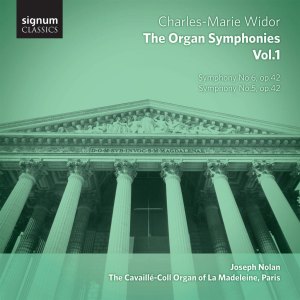 |
 |
|


alternatively
CD: MDT
AmazonUK
AmazonUS
Download
from The Classical Shop |
Charles-Marie WIDOR
(1844-1937)
Organ Symphony No.6, Op.42, No.2 (1879) [37:54]
Organ Symphony No.5, Op.42, No.1 (1879) [40:50]
 Joseph Nolan (organ)
Joseph Nolan (organ)
rec. 18-24 May 2011, L’église de la Madeleine, Paris
 SIGNUM CLASSICS SIGCD292 [72:35]
SIGNUM CLASSICS SIGCD292 [72:35]
|
|
|
Charles-Marie Widor was inspired to write symphonies for organ
on encountering the Cavaillé-Coll organ at Saint-Sulpice
in Paris, and so it makes complete sense to use these legendary
instruments to create the sounds Widor was so enthusiastic about
exploiting. The organ at la Madeleine has been used in recordings
of Widor before, such as that with Frédéric Ledroit
on the Skarbo label (see review).
The high note tuning issues/reverberation mentioned by William
Kreindler in 2008 appear not to be an issue with the present
recording, though I don’t have the Skarbo disc for comparison.
The sounds here, as the grand opening to the Symphony No.
6 testifies, are characteristic and a tremendous experience.
We’ve seen this coupling before of course, including that
with Colin Walsh on the Avie label (see review)
and from the Simax label played by Kåre Norstega. The
Simax recording comes from another Cavaillé-Coll organ,
that at l’Abbatiale St Etienne de Caen. This does have
a magnificent sound though is recorded with less weight in the
lower end of the spectrum, which means greater clarity but a
touch less oomph. This Signum recording is on the warmer side,
which creates a wonderful atmosphere in the slow movements and
generates an impressive general picture when everything is happening
at once.
These performances are also excellent. One of the more dubious
recordings I’ve long had of these pieces is from a 1994
box set on the Novalis label performed by Günther Kaunzinger.
His performances disappoint through being too rushed, and you
can hear how Joseph Nolan is far more prepared to allow his
instrument to create music at its natural pace rather than forcing
a more spectacular and ultimately less attractive interpretation.
Just as an example, Nolan’s Intermezzo in the Symphony
No. 6 is 6:16 to Kaunzinger’s 4:50, and Nolan doesn’t
sound in the least bit slow. His rhythm and articulation is
terrific in the Finale of this symphony as well.
The Organ Symphony No. 5 is by far the better known of
these two works, and largely on the strength of its final Toccata,
which is one of the best known organ pieces of all time. It
is good to hear the work complete of course, and I like Joseph
Nolan’s touch with the variation feel of the first movement,
adding little touches of rubato and keeping the expressive juices
while maintaining a feel for the bigger structural picture and
not pulling things around too much. He reminds us that there
is wit and humour in this music, as well as fizzing creativity
and impressive grandeur - a line which can be drawn back to
the terrific fun to be found in works by Lefébure-Wély
and further back to Balbastre and the like. The Allegro cantabile
second movement is more allegro than some, but still has its
gorgeous melodic flow over an ever-moving and restless accompaniment.
I relish the space and weight given to the opening of the Andantino
quasi allegretto, which moves across our aural landscape
like a very large, slowly rolling thing which you want to bite
into like balsa wood. The pastorale feel of the Adagio
is kept simple, acting as a preface to that famous Toccata,
which is superbly done. Joseph Nolan knows just how far he can
push his instrument without turning this cascade of notes into
meaningless mush, and you have a good sense of the multiple
layers of musical invention which have gone into the piece.
The final bars are truly stunning. Nolan’s timing is pretty
typical at just under 5 minutes excluding reverberation, as
compared to Günter Kaunzinger’s slightly mad 4:17
which results in half of the interval coffee cups being spilt
and the loss of just about all of the rhythmic subtleties in
the piece.
The booklet tells us that Joseph Nolan recorded his cycle of
Widor’s ten symphonies in just seven nights at L’église
de la Madeleine, which is no mean achievement. We can expect
the standard to be as high as this first volume and this looks
like being a set well worth collecting. The sound isn’t
perhaps the most revealing you’ll ever come across for
this type of organ repertoire, but the atmosphere and timbres
are all just as they should be, the performances putting this
amongst the top rank for these great works.
Dominy Clements
|
|

